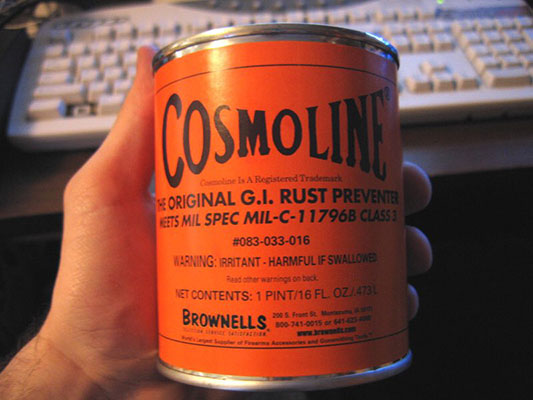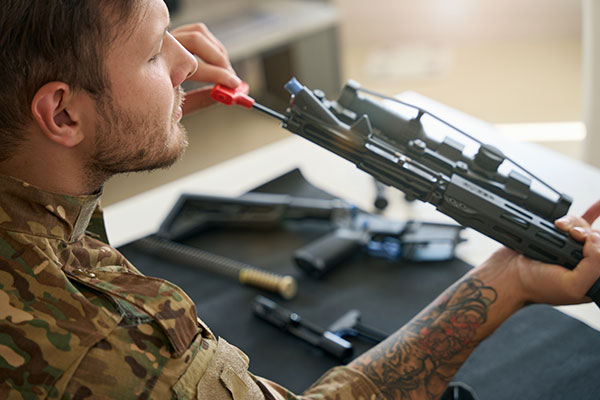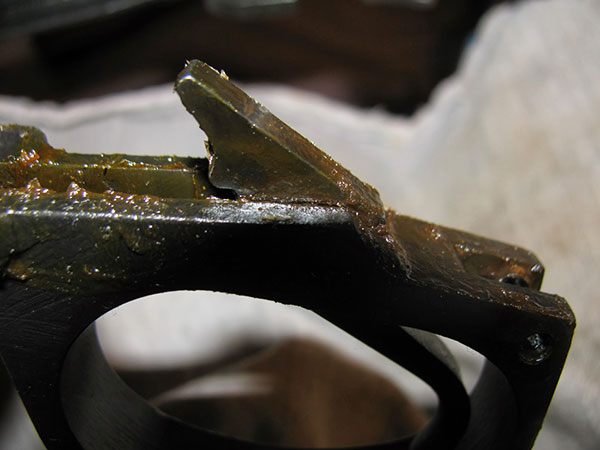Cosmoline can work wonders when it comes to protecting a stored firearm from rust, but all that anti-rust protection comes at the price of an extensive and messy cleanup.
So, just what is cosmoline, how did it gain mass usage, and most importantly, how do you get that glop off of your firearm?
 WHAT IS COSMOLINE?
WHAT IS COSMOLINE?
Believe it or not, cosmoline has been around for a long time, and it wasn’t originally used to protect guns from rust.
A company called Houghton International came up with cosmoline in the 1860’s or 1870’s—and they put it to use as a medical product. Specifically, an ointment that had an abundance of uses, including the stimulation of hair growth.
Veterinarians used cosmoline for cuts, scratches, bruises, and even sprains. Farmers used it to reduce swelling in cow’s udders.
It’s not really clear how cosmoline made the jump from cosmetics and medicine to a rust preventative, but when cosmoline received government approval, the military adopted it to coat their equipment in the Spanish-American War, World War I, World War II, the Korean War, and in Vietnam.
However, that brings us back to the question of what cosmoline actually is. It’s a petroleum-based rust inhibitor, usually in an oily wax. Cosmoline is always brown, but has differing levels of viscosity.
Aliphatic petroleum solvent is the chief ingredient in cosmoline. That substance is volatile, but eventually evaporates.
PREVENTING RUST
Because of its exemplary anti-rust characteristics, cosmoline was employed to keep machine tools, parts, and marine equipment free from rust.
It’s also common for cosmoline to be applied at the factory during the manufacture of disc brake rotors for automobiles—in order to thwart rusting inside the box before the rotor is installed.
 But it was during World War II that cosmoline truly earned the legendary reputation that continues to this day amongst firearm owners and enthusiasts. Because cosmoline is part of MIL-SPEC for Preservative and Sealing Compounds (MIL-C-11796C, for those of you keeping score at home), the US military used it to coat weapons of all kinds.
But it was during World War II that cosmoline truly earned the legendary reputation that continues to this day amongst firearm owners and enthusiasts. Because cosmoline is part of MIL-SPEC for Preservative and Sealing Compounds (MIL-C-11796C, for those of you keeping score at home), the US military used it to coat weapons of all kinds.
Certainly, it was used to preserve rifles and pistols. But it was also used to coat ENTIRE TANKS for protection from salty sea conditions during their overseas journeys. Massive coastal artillery batteries were “greased down” with cosmoline to thwart the corrosive ocean saltwater spray.
 GETTING COSMOLINE OFF YOUR FIREARM
GETTING COSMOLINE OFF YOUR FIREARM
Luckily, there are a number of ways to remove hardened cosmoline from your firearm.
Unluckily, none of them are really very easy. And, ALL of them are messy. Here are just a few ways to successfully remove cosmoline, although you’ll find that there are as many methods as there are types of weapons coated with the stuff.
Dry Ice Blaster. Highly pressurized air, combined with frozen solid CO2 particles, is focused on a cosmoline-coated area. The cosmoline is frozen, and falls off via gravity. Then, it’s just swept up. A skilled operator of the dry ice blaster is necessary, to keep from damaging the surface below the cosmoline. Properly wielded, the dry ice blaster is an ideal way to remove cosmoline.
Gentle Heat. Even hardened cosmoline can be removed by gently heating the substance till the hydrocarbons melt, and the waxy residue just melts or drips right off. As for the wood stock of many rifles, try removing as much of the cosmoline as possible, then putting the stock in the sun to let cosmoline that’s been absorbed into the wood grain slowly “cook” out. Then, just wipe clean. (It may take several sessions to get all the cosmoline, and you don’t want it seeping out while you’re shooting, so make sure you get it all.)
Soaked In Oil. Spraying a penetrating oil like WD-40 on the cosmoline, and allowing it to soak in for a period a time, will restore the cosmoline to a fluid that may simply be wiped off. It may take several “wiping downs” but it will eventually do the trick. How quickly will depend on the viscosity of the cosmoline.
Talcum, Mineral Spirits, Kerosene, And More. There are a number of other methods to removing cosmoline. One involves letting talcum powder absorb the cosmoline as it becomes a fluid with the application of heat. Mineral spirits and kerosene were popular solvents used in cosmoline removal during World War II.
The important thing to remember is that harsh chemicals or solvents can ruin the gun’s surface. So, go gently and apply elbow grease as needed.
 CLEANING UP
CLEANING UP
Removing cosmoline creates hazardous waste. So, there are designated methods to use when disposing of it. Never pour removed cosmoline down a household drain or sewer. The cosmoline will at some point harden again, and be difficult and costly to remove if blocking the flow of water.
Your best bet is to put it in an empty paint can or other secure container—and drop it off at any solid or toxic waste dropoff location (junkyard, landfill, etc.) when they have a hazmat day.
Embracing the outstanding anti-rust and anti-corrosion properties of cosmoline means also embracing the shared misery—and rite of passage—that goes hand in hand with REMOVING cosmoline. The best outlook is to appreciate the job cosmoline does, and to grin and bear the messy, laborious process of removing it forever from your firearm.

